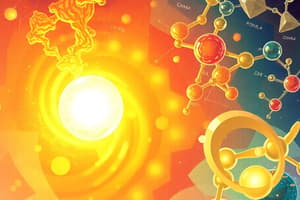Podcast
Questions and Answers
What is a mole?
What is a mole?
- The atomic mass of an element
- The volume of a gas at standard temperature and pressure
- A type of chemical reaction
- The SI base unit used to measure the amount of a substance (correct)
What is Avogadro's Number?
What is Avogadro's Number?
6.02 x 10^23
What does Molar Mass refer to?
What does Molar Mass refer to?
The mass of one mole of a pure substance.
What is Atomic Mass?
What is Atomic Mass?
What is Formula Mass?
What is Formula Mass?
Define Stoichiometry.
Define Stoichiometry.
What are mole-mole problems?
What are mole-mole problems?
In mass-mass problems, you must first balance the equation and then convert mass to ___ .
In mass-mass problems, you must first balance the equation and then convert mass to ___ .
What are mass-volume problems?
What are mass-volume problems?
Define limiting reactant.
Define limiting reactant.
What is expected yield?
What is expected yield?
Define actual yield.
Define actual yield.
What is percent yield?
What is percent yield?
What is molar volume?
What is molar volume?
Define percentage composition.
Define percentage composition.
What is an empirical formula?
What is an empirical formula?
What is a molecular formula?
What is a molecular formula?
What is a balanced chemical equation?
What is a balanced chemical equation?
Define chemical equation.
Define chemical equation.
What does a coefficient represent in a chemical equation?
What does a coefficient represent in a chemical equation?
Flashcards are hidden until you start studying
Study Notes
Mole and Stoichiometry Basics
- A mole is the SI unit for measuring the amount of substance, equivalent to the number of carbon atoms in 12 g of carbon-12.
- Avogadro's Number (6.02 x 10^23) quantifies the number of particles in one mole of a pure substance.
- Molar mass refers to the mass of one mole of a substance, typically expressed in grams per mole.
Atomic and Formula Mass
- Atomic mass is the total mass of an atom, combining protons and neutrons, measured in atomic mass units (amu).
- Formula mass is calculated by summing the atomic masses of all atoms within a chemical formula.
Understanding Stoichiometry
- Stoichiometry involves studying quantitative relationships in chemical formulas and reactions, crucial for predicting amounts of reactants and products.
- Mole-mole problems facilitate the conversion of moles from one reactant to another within a reaction.
Mass and Volume Problems
- Mass-mass problems require balancing equations, converting mass to moles, utilizing mole ratios, and converting back to grams or liters.
- Mass-volume problems relate the mass of a solute in grams to the overall mass of a solution, often expressed as a concentration.
- Volume-volume problems typically deal with gases, applying molar ratios and understanding that 1 mole of a gas occupies 22.4 L at Standard Temperature and Pressure (STP).
Reactants and Yields
- A limiting reactant is the component that restricts the amount of product formed in a chemical reaction, effectively dictating the reaction's yield.
- Expected yield is the theoretical amount predicted through stoichiometric calculations, while actual yield indicates the practical amount obtained post-reaction.
- Percent yield is calculated by taking the ratio of actual yield to expected yield, multiplied by 100 to express it as a percentage.
Gas and Chemical Formulas
- Molar volume defines the space occupied by one mole of gas at STP, which is 22.4 L.
- Percentage composition reflects the mass percentage of each element within a compound.
- Empirical formula indicates the simplest whole-number ratio of atoms in a molecule, whereas molecular formula specifies the exact number of each type of atom present.
Chemical Equations
- A balanced chemical equation ensures that the number of atoms for each element is equal on both reactant and product sides.
- A chemical equation expresses a reaction, with reactants on the left and products on the right, connected by an arrow.
- Coefficients are small whole numbers placed in front of chemical formulas within equations, indicating the quantity of molecules or moles involved.
Studying That Suits You
Use AI to generate personalized quizzes and flashcards to suit your learning preferences.




